
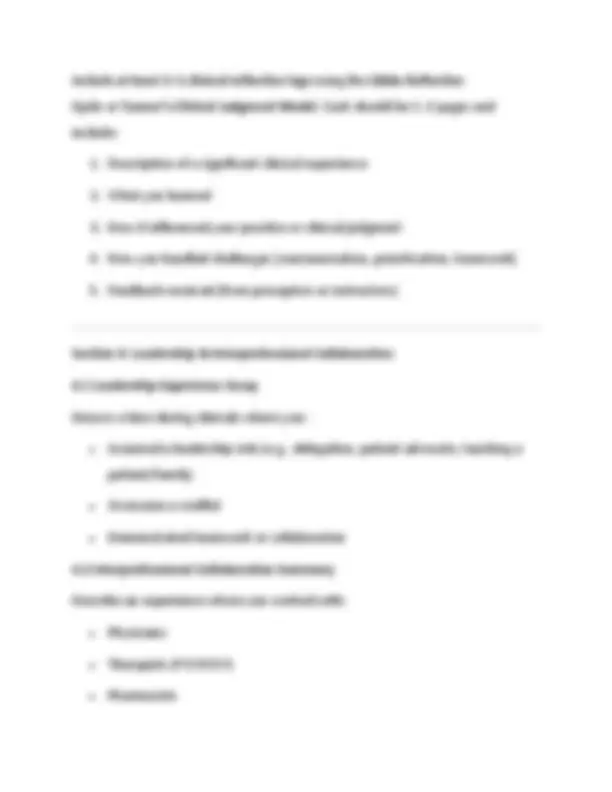
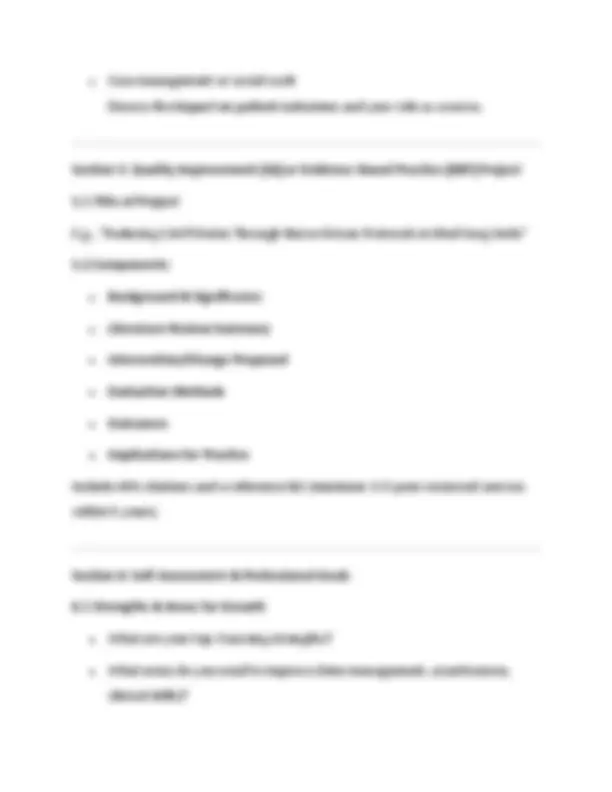
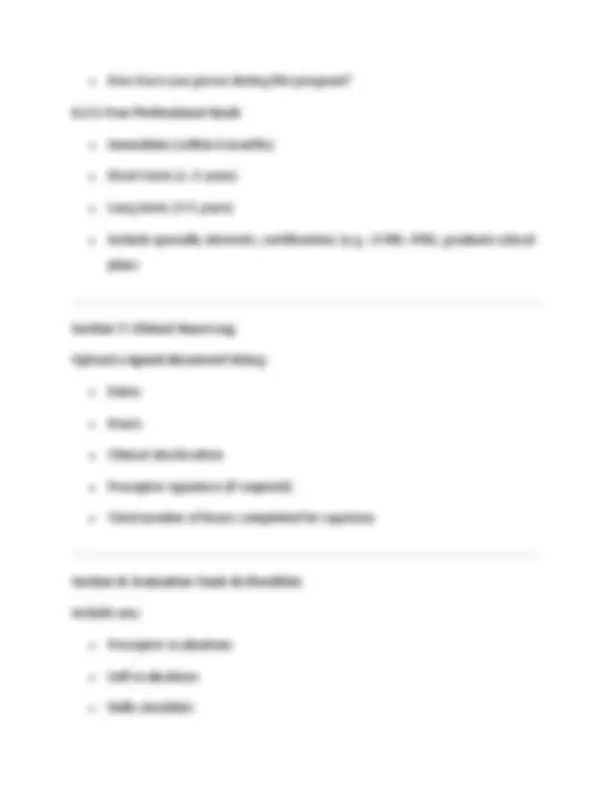
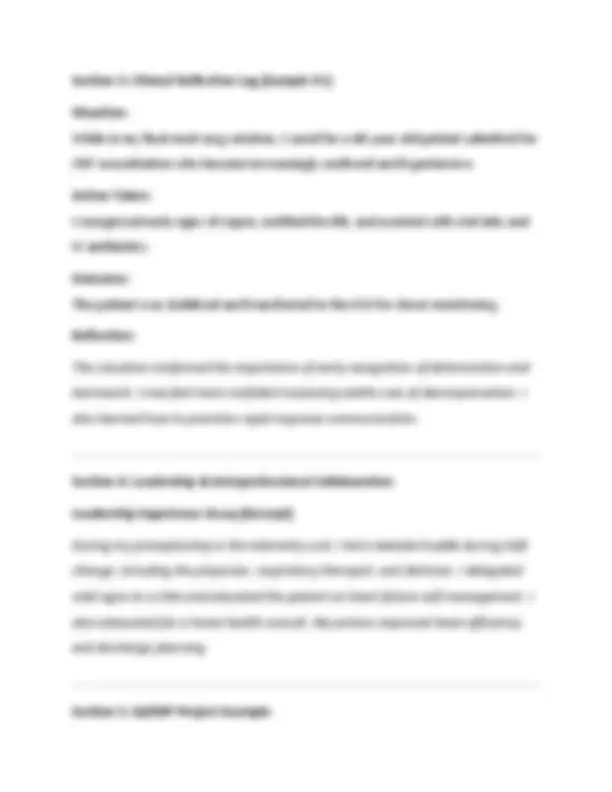

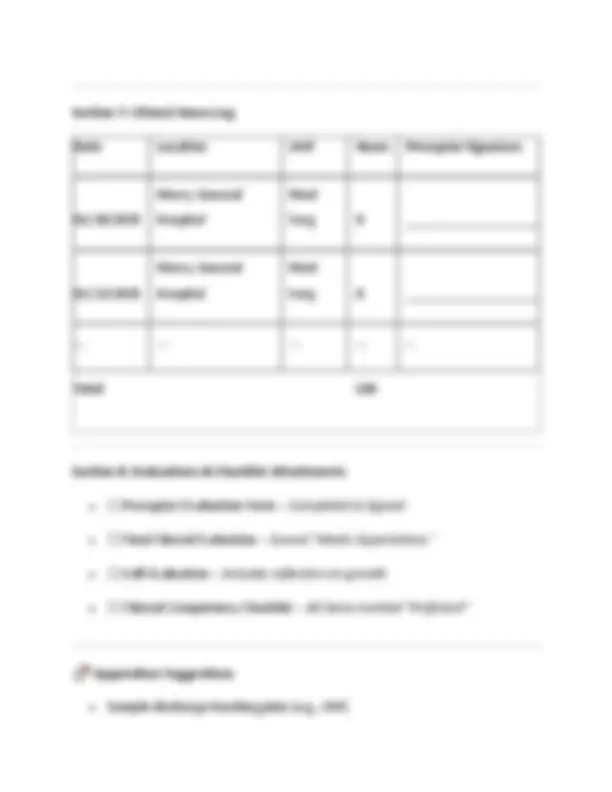
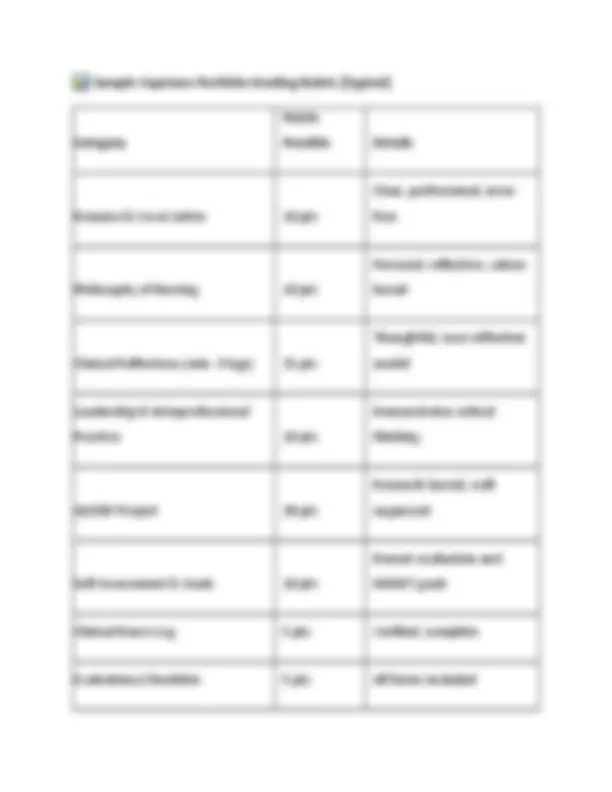
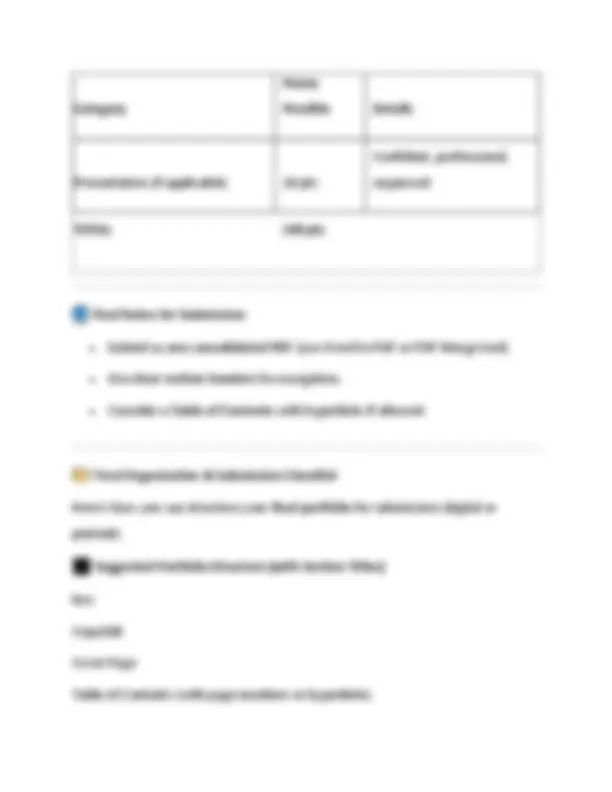
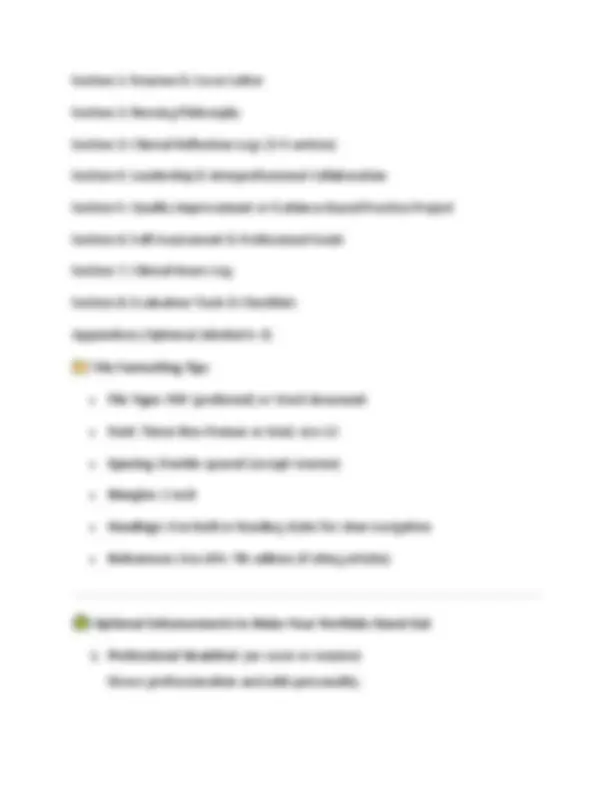
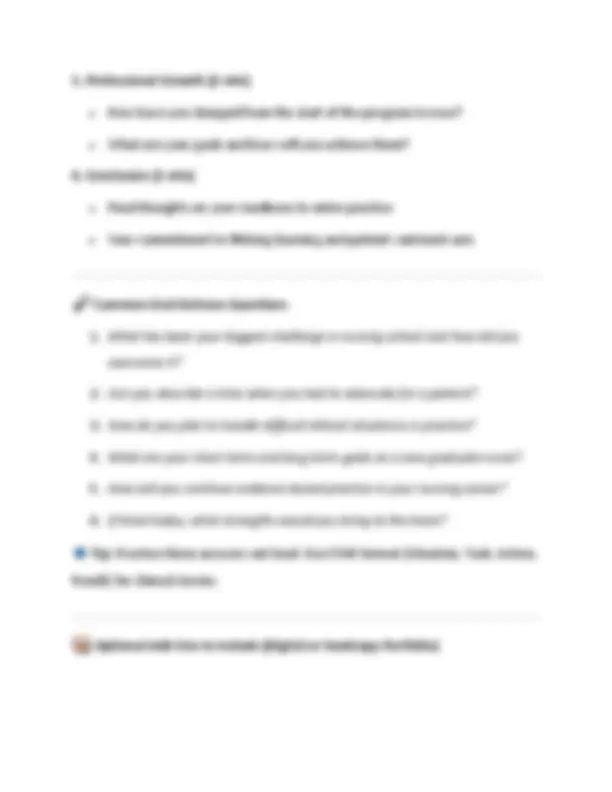
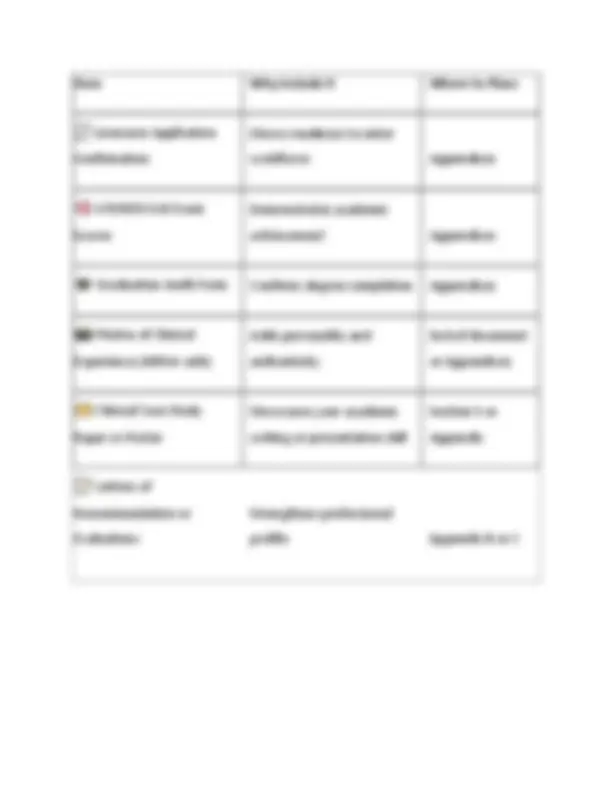


Study with the several resources on Docsity

Earn points by helping other students or get them with a premium plan


Prepare for your exams
Study with the several resources on Docsity

Earn points to download
Earn points by helping other students or get them with a premium plan
Community
Ask the community for help and clear up your study doubts
Discover the best universities in your country according to Docsity users
Free resources
Download our free guides on studying techniques, anxiety management strategies, and thesis advice from Docsity tutors
Capstone Portfolio for BSN NSG 4633: Transition to Practice, structured as a comprehensive document to help you prepare for your final portfolio submission. This includes examples and prompts that reflect the expectations of a senior-level BSN capstone portfolio.
Typology: Exams
1 / 19

This page cannot be seen from the preview
Don't miss anything!












Student Information
Section 1: Resume & Cover Letter Sample Resume Objective Compassionate and detail-oriented BSN-prepared nursing graduate with over 500 hours of clinical experience across medical-surgical, critical care, and community settings. Committed to delivering patient-centered care through evidence-based practice, strong clinical judgment, and collaborative teamwork. Cover Letter (Excerpt) Dear Nurse Manager, I am writing to express my strong interest in the New Graduate Residency Program at Memorial Regional Hospital. My clinical rotations in critical care and med-surg have strengthened my time management and prioritization skills. I am confident in my ability to provide holistic, evidence-based care and am eager to learn and grow in your interdisciplinary team. Section 2: Nursing Philosophy (Excerpt) I believe nursing is both a science and an art—grounded in evidence and expressed through compassionate care. My practice is rooted in Jean Watson’s Theory of Human Caring, emphasizing dignity, empathy, and trust. I entered nursing because I saw firsthand the difference nurses made during my grandfather’s palliative care. As a nurse, I strive to advocate for vulnerable populations, promote autonomy, and empower patients in their healing process.
Section 3: Clinical Reflection Log (Sample #1) Situation: While in my final med-surg rotation, I cared for a 68-year-old patient admitted for CHF exacerbation who became increasingly confused and hypotensive. Action Taken: I recognized early signs of sepsis, notified the RN, and assisted with stat labs and IV antibiotics. Outcome: The patient was stabilized and transferred to the ICU for closer monitoring. Reflection: This situation reinforced the importance of early recognition of deterioration and teamwork. I now feel more confident assessing subtle cues of decompensation. I also learned how to prioritize rapid response communication. Section 4: Leadership & Interprofessional Collaboration Leadership Experience Essay (Excerpt) During my preceptorship in the telemetry unit, I led a bedside huddle during shift change, including the physician, respiratory therapist, and dietician. I delegated vital signs to a CNA and educated the patient on heart failure self-management. I also advocated for a home health consult. My actions improved team efficiency and discharge planning. Section 5: QI/EBP Project Example
Section 7: Clinical Hours Log Date Location Unit Hours Preceptor Signature 01/20/ Mercy General Hospital Med- Surg 8 ___________________ 01/22/ Mercy General Hospital Med- Surg 8 ___________________ ... ... ... ... ... Total 120 Section 8: Evaluations & Checklist Attachments
Sample Capstone Portfolio Grading Rubric (Typical) Category Points Possible Details Resume & Cover Letter 10 pts Clear, professional, error- free Philosophy of Nursing 10 pts Personal, reflective, values- based Clinical Reflections (min. 3 logs) 15 pts Thoughtful, uses reflection model Leadership & Interprofessional Practice 10 pts Demonstrates critical thinking QI/EBP Project 20 pts Research-based, well- organized Self-Assessment & Goals 10 pts Honest evaluation and SMART goals Clinical Hours Log 5 pts Verified, complete Evaluations/Checklists 5 pts All forms included
Category Points Possible Details Presentation (if applicable) 10 pts Confident, professional, organized TOTAL 100 pts Final Notes for Submission
Q4: Can I reuse materials from earlier courses? A4: Yes—but revise and update them to reflect your current knowledge, growth, and standards for capstone-level work. Optional Oral Defense/Presentation (If Required) If your program includes an oral defense, poster presentation, or interview-style Q&A , use this structure and practice these common questions. Suggested Oral Defense Structure
1. Introduction (1 min) - Name, program, and capstone overview - Brief statement of your philosophy and what the portfolio represents 2. Key Clinical Experience (2–3 min) - Talk about a critical moment in clinicals - Emphasize your judgment, advocacy, or skill development 3. QI/EBP Project (2–3 min) - Present your project's purpose, intervention, and outcome - Highlight how it supports patient safety or nursing efficiency 4. Leadership/Collaboration Example (2 min) - Describe a situation that tested your communication or delegation - Share how you coordinated care with interprofessional teams
Item Why Include It Where to Place Licensure Application Confirmation Shows readiness to enter workforce Appendices ATI/HESI Exit Exam Scores Demonstrates academic achievement Appendices Graduation Audit Form (^) Confirms degree completion Appendices Photos of Clinical Experience (HIPAA-safe) Adds personality and authenticity End of document or Appendices Clinical Case Study Paper or Poster Showcases your academic writing or presentation skill Section 5 or Appendix Letters of Recommendation or Evaluations Strengthens professional profile Appendix B or C